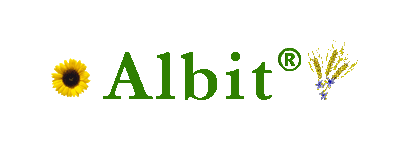|
|
Materials used in this chapter were published in the book: Biostimulant Albit for increasing yields and protection of agricultures against diseases, A.K. Zlotnikov, Ed. Prof. А. Melkumova. All-Russia Institute of Plant Protection, Russia, 2006. High agricultural efficiency might be obtained with joint application of Albit with fertilizers and means of leaf feeding (foliar liquid fertilizers). Firstly, Albit increases the utilization efficiency of fertilizers. Albit increases the coefficient of removal of nutrients from fertilizers (efficiency of use of mineral fertilizers by plants). In field trials carried out by Department of Agrochemistry of Moscow State University on spring barley and wheat, Albit was used in combination with various mineral soil applied fertilizers (according to standard regulation). In result, it was found that under conditions of averagely cultivated soil Albit is able to replace up to 18.7 kg/hectare of a.i. nitrogen (N2O5) and 14.2 kg/hectare of phosphorus (P2O5). In other words, this corresponds to:
Thus, application of Albit over one hectare makes possible reduction of mineral fertilizers application approximatelly by 10-30 % of normal rates without losses of their efficiency. Results of vegetative trials conducted in Department of Agrochemistry (Moscow State University), were subsequently confirmed by results of many conducted field trials (Table 1). For example, in field trial of State Stende Cereals Breeding Institute (Latvia, 2010-2011) full dosage of fertilizers (N5P20K26 300 kg/ha) delivered the yield of winter wheat of 72.7 c/ha. 15% reduced dosage of fertilizers together with Albit gave 74.8 c/ha, that brought high economical outcome (Table 1).
Table 1. Results of field trials on reducing of consumption of mineral fertilizers during Albit application
Effectiveness of Albit application on winter wheat was illustrated in field trial of State Stende Cereals Breeding Institute, Latvia (Table 2).
Effectiveness of Albit on winter wheat var. Fredis (State Stende Cereals Breeding Institute, Latvia, 2010-2011)
Addition of Albit (1 ml/10 L) to solution of fertilisers used for watering of greenhouse and field-grown vegetables established a good reputation in agricultural practice of vegetable growing farms of Krasnodar krai, Saratov and Moscow oblasts. In this case, Albit not only increases efficiency of fertilizers, but also immunizes plants against diseases. In details, the agrochemical properties of Albit are described here. Secondly, mineral fertilizers (basically urea) are used sometimes for leaf feeding during vegetation period. Application of urea on wheat provides both supplying of plants with additional nitrogen for yield formation and increased gluten content in seeds. To increase winter wheat grain quality, leaf feeding with urea (30-40 kg of active ingredient per 1 hectare applied through spraying) in EC stages 50-69 is generally used. Application of such rates requires concentration of urea in working solution of 10-15%, or even 30% in case of aerial application. However, it is known that urea concentrations over 1% cause plant burns. Usage of effective antistressor, such as Albit, can solve this problem. Joint application of Albit with urea provides full relieve of stress effect of urea fertilizing. All this urea-relating information can be used in cases of leaf feeding with ammonium nitrate, with mixture of urea and ammonium nitrate and with other means of leaf feeding. Albit has been successfully used in combination with urea (leaf feeding in vegetation period) in practice of farms of Rostov, Tambov, Voronezh and Oryol oblasts of Russia over several years. Also, high efficiency of three-component solution of urea, Albit and insecticide has been demonstrated. |
|
||||||||||||||||||||||||||||||||||||||||||||||||||||||||||||||||||||||||||||||||||||||||||||||||||||||||||||||||||||||||||||||||||||||||||||||||||||||||||||||||
Terms and Conditions
|
|


